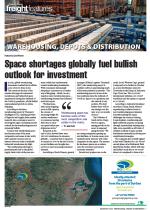Technology is changing the face of the warehousing industry as more and more companies adopt Warehouse Management Software (WMS) as part of their operations and practices.The reason for this, says Luke Taylor, execution champion at Forte Warehouse Solutions, is to negate operational inefficiencies and stock losses. “There is a real drive to create value through control, and using advanced technologies like business intelligence (BI) reporting tools is a key component of this adoption.”Speaking to Freight News, Taylor explains that the use of WMS-connected scanners is also becoming more common among warehouses that previously ran their operations on either Enterprise Resource Planning (ERP) software or a simple Excel sheet. “Some players, however, are still hesitant to present the capital outlay necessary to implement these systems. Whilst the benefits are apparent, the macroeconomic market conditions do play a role and the room for growth and capital expenditure is limiting for some.”Another ongoing trend in the warehousing sector globally is the increased use of artificial intelligence (AI). According to Taylor, locally several very advanced and well-funded operations utilise AI increasingly in their operations, but this is certainly not the case for the broader South African market. “This could change, depending on the barriers to entry of these technologies in the coming years, as the benefits are vast.”He says the top trend locally is the use of BI reporting tools. “These are becoming common to identify bottlenecks and inefficiencies, as well as to give the warehouse managers and operators a quick view on key business aspects; namely, the number of transactions, orders, key performance indicators and the like.”Budgeting, however, remains one of the biggest challenges in the sector. “It is a primary concern when it comes to growth and expansion, given the fact that we’re riddled with load shedding and high staff turnover,” says Taylor. “However, the potential of the South African economy is huge and with the correct investments we can manage the skills gap that seems to plague some operations. “The use of WMS technology will enable businesses to minimise losses and use that capital to fund further development, which brings a further benefit. The use of technology is now at a level where the costs are not prohibitive, the internet is widespread and cheap, and most labourers own Android devices and work on a PC at some point, so the learning curve is far less steep. We are primed for an explosion of advancement through technology and connectivity.”Warehousing, he says, is a necessary component of any functioning economy, so the demand is strong. “I see improvement coming, but the macro and local climate are what dictate how quickly we will implement the upgrades to more advanced technologies and practices. “The variation between lower-budget manual operations, mid-tier operations and very advanced warehouses is wide. The lower-cost warehouses would seem bizarre to overseas clients – how they manage to operate would be a mystery to them – but we make it work,” he explains. “The mid-tier is probably slightly behind the rest of the world, but using a WMS integrated into ERP is standard practice. The very advanced warehouses locally employ industry-leading technology and would compete with the highest efficiencies of a global player.”From a distribution point, Taylor says players are being pushed to implement WMS by the financial and compliance sectors of their business. “Most fast-moving consumer goods (FMCG) will require batch management. Therefore, to negate fines and legal issues, there is a big drive to implement controls that come with a WMS. “Most warehouse owners know the clock is ticking to get their system transparent and, most importantly, to manage the stock levels between ERP and WMS.”

